The Society of Environmental Journalists is pleased to announce the winners of the SEJ Awards for Reporting on the Environment, which honor the best articles, radio broadcasts and videos released from March 1, 2019, through February 29, 2020, and the best books on environmental topics published in 2019.
The SEJ contest is the world's largest and most comprehensive environmental journalism competition. The number of entries in the 2020 contest peaked at 499, another all-time high for the contest. Entries were judged by independent panels of journalists and professors.
Winners were honored at the #SEJ2020 Virtual Conference on Sept. 16, 23 and 30, including the live announcement of the winner of the Nina Mason Pulliam Award and $10,000 cash prize, selected from the first-place winners in all categories.
SEJ's 2020 Awards for Reporting on the Environment are...
Kevin Carmody Award for Outstanding Investigative Reporting (Large Newsroom or Circulation)
Kevin Carmody Award for Outstanding Investigative Reporting (Small Newsroom or Circulation)
Outstanding Beat Reporting (Large Newsroom or Circulation)
Outstanding Beat Reporting (Small Newsroom or Circulation)
Outstanding Explanatory Reporting (Large Newsroom or Circulation)
Outstanding Explanatory Reporting (Small Newsroom or Circulation)
Outstanding Feature Story (Large Newsroom or Circulation)
Outstanding Feature Story (Small Newsroom or Circulation)
Outstanding Student Reporting
Rachel Carson Environment Book Award
SEJ's 2020 Distinguished Judges
SEJ's 2020 Awards Committee
Kevin Carmody Award for Outstanding Investigative Reporting (Large Newsroom or Circulation)
First Place
"Polluter’s Paradise" by Tristan Baurick, Joan Meiners, Gordon Russell and Sara Sneath, The Times-Picayune and The Advocate, and Claire Perlman, Al Shaw and Lylla Younes, ProPublica
 |
| The Eastman Chemical Company in St. Gabriel. (Chris Granger/The Times-Picayune and The Advocate) |
Story links:
- "Welcome to "Cancer Alley," Where Toxic Air Is About To Get Worse"
- "In a Notoriously Polluted Area of the Country, Massive New Chemical Plants Are Still Moving In"
- "How Oil Companies Avoided Environmental Accountability After 10.8 Million Gallons Spilled"
- "In "Cancer Alley," Toxic Polluters Face Little Oversight From Environmental Regulators"
- "Chemical Companies Are Building Their Plants Overseas and Shipping Them Back In. They Still Get State Tax Breaks."
Judges' comments: At a time when the current White House is rolling back at least 100 environmental regulations, and as the nation's unrest over systemic racism and the public health catastrophe of COVID-19 has cast a new light on the role environmental injustice plays into both, no 2019 series could be more timely than the sustained, yet fresh investigative coverage of Louisiana's "Cancer Alley."
Before COVID and after COVID, residents along the banks of the Mississippi River between Baton Rouge and New Orleans were battling and will continue to battle a public health crisis against the carcinogenic emissions of petrochemical plants, which are still proliferating. The reporting team combined traditional document discovery and analysis skills with information developed through extensive interviews to expose a weak regulatory structure that allows out-of-control spills and emissions to go unpunished. The lead piece in the series does exactly what modern environmental justice reporting should do. It blends data with human impact, and binds them together with riveting writing that captures the nuance of living with toxics.
For example, there is this passage:
The old custom of sitting outside on summer evenings fell out of favor long ago, residents said, thanks to nighttime chemical releases — sometimes so thick they'd fall as a golden mist.
"It'd look like raindrops but yellow,” Grace said. “We'd have to hose our yards clean."
In the lawns, people would often find dead birds.
The series also did something else very important. It did not depict African Americans only as victims of pollution. It depicted them as empowered, trying to fight with the moral force of boots on the ground. In St. Gabriel, activist Hazel Schexnayder said that community outrage in 1993 over a proposed hazardous waste facility has led to sustained vigilance.
"When companies come in here with a new plant, all we have to do is go to meetings and say, 'We don't want that here,'" Schexnayder said. "If we fill a room, they know we can vote them out. They have to listen to us."
By tying together top-rate investigative reporting on industry regulation (or lack of) with sensitive chronicling of the impact of toxic industries on residents, this series is our 2020 winner for the Kevin Carmody Award for Outstanding Investigative Reporting (Large Newsroom or Circulation).
Second Place
"The Grumman Plume: Decades of Deceit" (PDF) by Paul LaRocco and David M. Schwartz for Newsday
Judges' comments: This investigation of Grumman International's carcinogenic groundwater "plumes" under southern Long Island mines newly discovered confidential documents to trace how decades of government and corporate coverup and deceit have damaged the regional water supply and endangered public health. Although the contamination of the underground water plume has been known for decades, this very well-written entry weaves together the economic and social history of Grumman on Long Island with discoveries of new evidence illuminating what the company and regulators knew and when they knew it. In the process, the reporters unfold a riveting story in a style that deftly blends exposé with a grim whodunit. It is reminiscent of Dan Fagin's 2014 nonfiction Pulitzer Prize-winning book, "Toms River."
Third Place
"The Green Blood Project" by Arthur Bouvart, Paloma Dupont de Dinechin, Jules Giraudat, Marion Guégan, Laurent Richard, Cécile Schilis-Gallego and Audrey Travère for Forbidden Stories
Story links:
- "Green Blood"
- "Silence Is Golden for a Tanzanian Mine"
- "A Damning Photo Holds a Swiss-Russian Mine Accountable in Guatemala"
- "Sand Mafias Silence Journalists in India"
- "Mines' Dirty Secrets Echo on Three Continents"
Supplemental materials: Publications by media partners
Judges' comments: "The Green Blood Project" by Forbidden Stories is an important story that exposes the human rights violations and environmental risks posed by the mining industry around the world. The investigation documents the harm that journalists face while reporting on environmental issues in many parts of the planet. The project, a herculean collaboration between 15 different media partners globally, finishes the reporting begun by journalists who lost their lives reporting on the mining industry and focuses on three mining giants in Tanzania, Guatemala and India. The bold investigation reminds us that exposing and holding the powerful accountable can be a costly affair in some parts of the world and freedom of the press isn't to be taken for granted, and yet seeking the truth and reporting it is at the heart of journalism.
First Honorable Mention
"Flint's Deadly Water" by Jacob Carah, Sarah Childress, Abby Ellis, Frank Koughan and Kayla Ruble for PBS Frontline
Judges' comments: While most national media outlets moved on after the Flint Water Crisis appeared to come to a partial resolution (residents are still lining up for bottled water), Frontline reporters stayed on the case with an enraging two-year investigation into an aspect of the crisis that never received the focus that the lead in the water supply did: The dozens of deaths from Legionnaires' disease and pneumonia.
The team did a thorough job in laying out the dominoes of indifference, incompetence, obstruction and dereliction by public health officials, particularly at the state level. They also did something that the national media failed to do in its coverage of lead in the water. In a half Black city, Frontline gave significantly more voice to African American residents and activists dealing with the crisis, depicting them with an agency rarely depicted during the crisis.
Second Honorable Mention
"Climate Change, Inequality and FEMA's Hidden Disaster Data" by Robert Benincasa and Rebecca Hersher for National Public Radio
Story links:
- "How Federal Disaster Money Favors the Rich"
- "Search the Thousands of Disaster Buyouts FEMA Didn't Want You To See"
Judges' comments: NPR’s investigation shines a light into racial disparities in how the government doles out federal aids and buyouts after a disaster. NPR’s team of reporters sued the federal government agency Federal Emergency Management Agency (FEMA) to get detailed records on buyouts and found that a disproportionate amount of aid goes to rich white neighborhoods. Their portrayal of two families from the same neighborhood who experience completely different realities was powerful. With a mix of original data analysis, records gathering, academic collaboration and shoe-leather reporting, the judges think this investigation deserves attention and high praise.
Third Honorable Mention
"Poaching Threatens South America's Only Bear Species" by Eduardo Franco for National Geographic
Judges' comments: This well-written investigative article exposed the illegal poaching of endangered Andean bears, also known as spectacled bears, and the use of their body parts by shamans in traditional folkloric medicine to heal, give strength and, as in the case of the bears' penile bones, as an aphrodisiac for Peruvian men. The journalist traveled thousands of miles and worked undercover to talk with bear hunters, shamans and government officials who, because of inadequate budgets and understaffing, are virtually powerless to stop the killing of South America's only bear species and also the lucrative export of body parts.
Kevin Carmody Award for Outstanding Investigative Reporting (Small Newsroom or Circulation)
First Place
"Unwell Water" by Kyle Bagenstose and Jenny Wagner for Bucks County Courier Times
 |
Story links:
- "The $2 Billion Bout" and "States, Experts Say EPA Role on Chemicals Is Crucial" (PDF/same date)
- "Five Years After Discovery, PFAS Concerns Continue" and "PA Lawmakers, Regulators Struggle To Address Chemical Contamination" (PDF/same date)
- "Docs: Military Chemical Hazards Going Unaddressed" (PDF)
- "Why Isn't the Military Cleaning Up Firefighting Chemicals?" (PDF)
- "Military Ignores EPA on Chemicals" (PDF)
Judges' comments: This excellent five-part series investigated the foot-dragging and legal maneuvering that has slowed cleanup of toxic firefighting chemicals around military bases. Kyle Bagenstose and Jenny Wagner's thorough reporting over an eight-month span detailed efforts by U.S. Department of Defense officials to avoid liability for cleaning up contaminated streams and aquifers. Extensively documented and well-sourced, this series shines important light on a dysfunctional regulatory process.
Second Place
"Permit Eyes Tons of Oilfield Pollutants for Boysen, Wind River" by Angus M. Thuermer Jr. for WyoFile
Story links:
- "Permit Eyes Tons of Oilfield Pollutants for Boysen, Wind River"
- "Residents Fret About Oilfield Dumping Plan for Bighorn River"
- "Boysen, Moneta Plan Draws Sharp Divide Between Counties"
- "EPA: Oilfield Pollution May Significantly Degrade Wind River"
- "DEQ Backs Off Plan To Dump More Oilfield Pollutants Into Boysen"
Judges' comments: WyoFile's Angus M. Thuermer Jr. dug deeply into what might have been a routine state permit for dumping oilfield waste into protected waters. Thuermer's stories tracked how regulators' jargon hid acceptance of flawed industry assurances and the likelihood of degraded water quality. The stories stirred public opposition, and ultimately EPA criticism forced the state to withdraw the permit. The series demonstrated the power of challenging assumptions.
Third Place
"Cured in Place? An Underground Pipe Repair Raises Questions." by Robin Lloyd for Undark
Judges' comments: Robin Lloyd masterfully lays out the safety issues connected to the booming 'cured-in-place' plastic piping sheaths used to repair miles and miles of sewer pipes nationwide. Lloyd takes us inside the battle that ensued when scientists red-flagged harmful exposure at daycare centers, schools and even homes – and industry's efforts to silence them. A very readable, accessible environmental accountability story happening right under our noses.
First Honorable Mention
"Getting 'Results'" by Enrique Saenz for Indiana Environmental Reporter
Story links:
- "IDEM Investigating Chemical Spill Near Indiana Dunes National Park"
- "Advocacy Groups Threaten To Sue Indiana Steel Mill Company for Federal Water Quality Violations"
- "Environmental Groups Sue EPA To Force Tighter Emissions Controls at Steel Mills"
- "Steel Mill Denies Manipulating Spill Data"
Judges' comments: When a steel mill's toxic spill into Indiana's Little Calumet River killed fish and caused other problems, Enrique Saenz of Indiana Environmental Reporter followed state and company reports and actions. Readers and podcast listeners learned from Saenz's reporting how state regulators failed to alert local officials why environmental groups threatened to sue the company over illegal discharges.
Second Honorable Mention
"Drilling Deep: Green California's Oil Regulators Invest in Companies, Issue Illegal Permits, Ignore Spills" by Janet Wilson for The Desert Sun
Story links:
- "'Outrageous Conflicts of Interest': Watchdog Groups Urge California Gov. Gavin Newsom To Fire Oil Regulators"
- "California Oil Regulators Made 'Dummy' Approval Files for Risky Drill Permits, Records Show"
- "California Natural Resources Secretary Probing 'Dummy' Files at Oil and Gas Agency"
- "California Presses Chevron for Data on Oil Field Where 8 Spills Have Happened Since April"
- "Gov. Newsom Halts New Steam Injection, Oil Fracking in California"
Judges' comments: Janet Wilson's reporting for the Desert Sun revealed significant problems in California's Division of Oil, Gas, and Geothermal Resources, including the practice of creating "dummy files" to allow petroleum companies to circumvent upfront reviews of risky projects.
Outstanding Beat Reporting (Large Newsroom or Circulation)
First Place
Beat Reporting by Hal Bernton and Daniel Beekman for The Seattle Times
Story links:
- "Bonneville, the Northwest's Biggest Clean-Power Supplier, Faces Promise and Perils in Changing Energy Markets"
- "As Bering Sea Ice Melts, Alaskans, Scientists and Seattle's Fishing Fleet Witness Changes 'on a Massive Scale'"
- "Why Are Birds and Seals Starving in a Bering Sea Full of Fish?"
- "Natural Gas Industry's $1 Million PR Campaign Sets Up Fight Over Northwest's Energy Future"
- "As Climate Change Melts Alaska's Permafrost, Roads Sink, Homes Tilt and Greenhouse Gases Release"
Judges' comments: Hal Bernton's impressive package of deeply researched stories on critical current environmental issues shows extensive scope and range. His lively writing and evocative images make dense topics interesting, and the impacts on readers clear. This is environmental beat reporting at its finest.
Second Place
Natasha Daly's Animal Welfare Reporting for National Geographic
Story links:
- "Flying Foxes Are Dying En Masse in Australia's Extreme Heat"
- "Inside the Efforts To Help Animals Hurt by the Amazon Fires"
- "How One Amazon Community Is Trying To Move On From Illegal Wildlife Tourism"
- "In This Thai Village, Life Revolves Around 300 Captive Elephants"
- "Chinese Citizens Push To Abolish Wildlife Trade As Coronavirus Persists"
Supplemental materials:
Judges' comments: This compelling and heartbreaking collection of stories illustrates how animal welfare intersects with culture, and the ways in which the latter exploits the former. Natasha Daly's evocative writing brings foreign worlds and creatures to life, and shows why we should care. The reporting also shows enterprise in utilizing Instagram to accomplish investigative work.
Third Place
"New York's Climate and Energy Policy" by Marie French for Politico
Story links:
- "New York Takes Lead in Climate Change Fight"
- "Governors Eye Regional Cap and Trade Plan To Fund Transition From Fossil Fuels"
- "Proposal Before Grid Operator Would Restrict Press Coverage" and related same-day story: "Plan To Limit Coverage of Grid Operator's Meetings Abandoned"
- "Natural Gas Utilities Grapple With Climate Goals" (PDF)
- "Longtime Tension Between State Regulators and Power Markets To Emerge Again" (PDF)
Judges' comments: With this package of stories demonstrating development of a deep bench of sources and mastery of a range of timely topics, Marie French reminds the reader why journalism and transparency matter. Her work is emblematic of outstanding reporting on the environmental policy beat.
First Honorable Mention
Climate Change Beat Reporting by Alex Harris for The Miami Herald
Story links:
- "Feds Consider a Plan To Protect Miami-Dade From Storm Surge: 10-Foot Walls by the Coast"
- "As Seas Rise, Your Coastal Home in Florida Could Lose Value. One Report Says 15% by 2030"
- "A Town's Pioneering Plan To Fund Retreat From Sea Rise: Have New Development Pitch In"
- "Adapting to Climate Change Is Going To Cost Florida a Lot. Who's Going To Pay for It?"
- "At $60 Million a Mile, The Keys May Abandon Some Roads To Sea Rise Rather Than Raise Them"
Judges' comments: Alex Harris has produced a solid collection of stories with great significance and impact for South Florida readers. As the Miami Herald's first reporter to dedicate her time to reporting on climate change, Harris turns environmental science reports into engaging stories using her skills as a writer and videographer. The consequences of rising sea levels — the main topic of her submissions — are relayed to her audience in the ways that matter most to them: economic, political and social impacts. By honoring the work of this reporter, the jury would also like to acknowledge the Miami Herald's substantial commitment to environmental reporting, and its efforts to amplify their impact through collaborations with other media throughout the state.
Second Honorable Mention
"Solutions to Global Environmental Problems" by Amy Yee for New York Times, Washington Post and Science Magazine
Story links:
- "The Elusive Animal in the Spotlight Amid the Coronavirus Crisis"
- "The Future of Wine: Very, Very Dry"
- "Mozambique Looks Beyond Cyclone Idai to Better Protection in the Future"
- "Electronic Marvels Turn Into Dangerous Trash in East Africa"
- "Nowhere to Hide: These Odd, Scaled Mammals Are the Most Poached in the World — and They Could Go Extinct"
Judges' comments: Amy Yee's submission impressed the jury with her ambitious solutions-oriented reporting, and the wide range of issues she tackled. Her work, published in the New York Times, the Washington Post and Science Magazine, brought us from the vineyards of Israel to coastal Mozambique, showing that there are no boundaries in environmental reporting. That she managed to accomplish this work on a shoestring budget as a solo freelancer is testament to her commitment and passion for environmental journalism.
Third Honorable Mention
"Saving Manila Bay" by Carolyn Bonquin for CNN Philippines
Story links:
- "Tullahan: Reviving a Dead River"
- "Government Struggles To Remove Illegal Structures From Manila Bay"
- "Critical Habitat Near Manila Bay Under Threat From Trash"
Judges' comments: The judges were struck by Carolyn Bonquin's well-researched and presented stories about the deeply intertwined complexities of cleaning up extremely polluted Manila Bay. The visuals are searing, but Bonquin did an excellent job of explaining them and connecting us to the people who live there and can't just look away.
Outstanding Beat Reporting (Small Newsroom or Circulation)
First Place
"Holding the Powerful to Account for the Environment" by James Bruggers for Inside Climate News
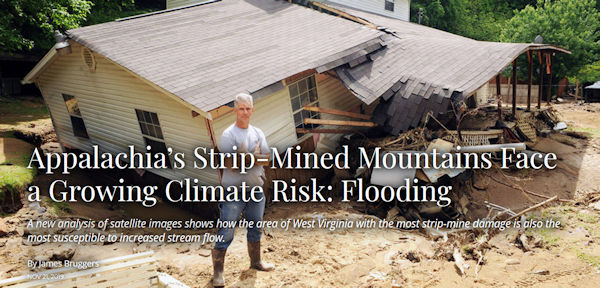 |
| Photo courtesy Inside Climate News |
Story links:
- "Appalachia's Strip-Mined Mountains Face a Growing Climate Risk: Flooding"
- "McConnell's Record on Coal Has Become a Hot Topic in His Senate Campaign"
- "Not Trusting FEMA's Flood Maps, More Storm-Ravaged Cities Set Tougher Rules"
- "Inside a Southern Coal Conference: Pep Rallies and Fears of an Industry's Demise"
- "Southern Cities' Renewable Energy Push Could Be Stifled As Utility Locks Them Into Longer Contracts"
Judges' comments: This entry stood out as the judge's top choice for versatility of topics, depth of reporting and skillful writing to create five very readable stories on regional environmental and energy problems and politics. Down-to-earth analysis shined a light on inadequate federal maps to predict flooding and erosion from mine runoff, flooding of coastal properties and a utility's bias in seeking to renew expensive fossil fuel contracts. James Bruggers used both grit and finesse in lining up a wide variety of sources inside and outside government. A nice human touch gave voices to coal miners, small town mayors and politicians from both parties concerned about whether a powerful senator was protecting miners' pensions and black lung payments amid the transformation of an ailing coal country. We get a sense of place in coal country. We also get an appreciation of how regulation of climate change can affect people's lives. In short, the entry showed how a beat reporter can use ingenuity and hard work to produce fresh stories that inform and are pleasurable to read.
Second Place
"Toxic Injustices: Communities and Children Assaulted by Trump's Environmental Rollbacks" by Derrick Z. Jackson for American Prospect Magazine and the Union of Concerned Scientists
Story links:
- "Toxic Injustices: Priority for Abused Communities Must Pervade Every Aspect of a Green New Deal"
- "Let the Children Breathe Particulate Matter: How the Trump Administration's Polluted Policies Are Hurting Children"
- "Natural Gas vs. Renewable Energy: Beware the Latest Gas Industry Talking Points"
- "Asbestos, Ubiquitous and Avoidable, Is a Deadly Threat to Our Kids"
- "EPA's New Water Rule a Mockery of Science and the Clean Water Act"
Judges' comments: This sharply written commentary draws the reader into serious environmental issues, including the dismantling of existing regulations and the gutting of EPA enforcement in favor of permitting. These five columns exude both science and humanity while targeting environmental disasters such as asbestos, fossil fuels and the endemic pollution of air, soil and water along with degraded wetlands. Derrick Jackson peppered his stories with poignant anecdotes about people and issues often forgotten by the media.
Third Place
"The CO2 Beat" by Mark Kaufman for Mashable
Story links:
- "Fearless TV Weather Forecasters Air the Planet's Soaring Carbon Levels"
- "Since the First Earth Day, the Planet's CO2 Levels Have Gone off the Rails"
- "Where Australia's Smoke Goes To Die"
- "World's Carbon Emissions Grew in 2019 to Their Highest Levels Ever"
- "The Ocean Keeps Sucking a Colossal Amount of CO2 From the Air, But Will It Last?"
Judges' comments: Who knew CO2 could be so interesting? Kaufman's authoritative, lively, entry exemplifies beat reporting at its best: weighing oceanic appetite for CO2, tracking the global circulation of CO2 released by wildfires in Australia, Alaska, reflecting on the atmospheric buildup of CO2 since the first Earth Day in 1970. Charts, tweets and other graphics boost comprehension throughout. Supporting links, drawing upon the writer's previous reports, further demonstrate his mastery of the subject matter.
First Honorable Mention
"Bad Chemistry" by Sharon Lerner for The Intercept
Story links:
- "3M Knew About PFAS Food Contamination in 2001"
- "EPA Move To Phase Out Animal Experiments Could Mean the End of Toxics Regulations"
- "EPA Allowed Companies To Make 40 New PFAS Chemicals Despite Serious Risks"
- "Toxic PFAS Chemicals Found in Artificial Turf"
- "Top U.S. Toxicologist Was Barred From Saying PFAS Cause Disease In Humans. She's Saying It Now."
Supplemental materials:
Judges' comments: Sharon Lerner has written extensively and often first on issues of the "forever" manmade chemicals PFAS in firefighter and military foam, GenX, some artificial turf and nonstick household goods.
Second Honorable Mention
"Anti-Protestor Legislation" by Naveena Sadasivam for Grist
Story links:
- "After Standing Rock, Protesting Pipelines Can Get You a Decade in Prison and $100K in Fines"
- "Texans Could Get a Year in Prison for Protesting Pipelines on Their Own Land"
- "Why Greenpeace Activists Dangled From a Bridge in Texas — and Face 2 Years in Prison"
- "Trespass Near a Pipeline, Go to Prison for 6 Years? It Could Happen in Wisconsin."
- "This Pipeline Cuts Across a Reservation. Wisconsin Might Make Tribal Members Felons for Protesting It."
Judges' comments: Naveena Sadasivam's tight, wide-ranging reporting on new statutory penalties against protestors, including heavy fines, documents what amounts to a national counter offensive by the oil and gas industry.
Third Honorable Mention
"Bears Ears, Voting Rights and Legal Bills: Beat Reporting from San Juan County, UT" by Zachary Podmore for The Salt Lake Tribune
Story links:
- "San Juan County Paid Nearly $500K to Louisiana Law Firm To Lobby for Bears Ears Reductions"
- "As San Juan County Considers Tax Hike, a Struggling Copper Mine Owes $1.4 Million"
- "San Juan County, Utah's Poorest and Highest Taxed, Is Headed for a Tax Hike"
- "Sutherland Institute's Campaign Against Bears Ears Was Relentless, Effective and Mostly Funded by a Tight Circle of Activists"
- "Recapture Canyon Case Costs San Juan County $440,000"
Judges' comments: Zachary Podmore's stories do a good job of exposing a poor Utah county's steep legal fees and secrecy in fighting a federal decision to establish the Bears Ears National Monument.
Outstanding Explanatory Reporting (Large Newsroom or Circulation)
First Place
"2°C: Beyond the Limit" by Brady Dennis, Juliet Eilperin, Darryl Fears, Chris Mooney, Steven Mufson, John Muyskens, Aaron Steckelberg, Harry Stevens and Monica Ulmanu; photography by Salwan Georges and Bonnie Jo Mount; photos and videos by Carolyn Van Houten; and graphics by John Muyskens and Harry Stevens for The Washington Post
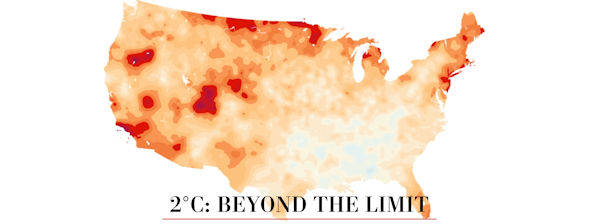 |
Story links:
- "Extreme Climate Change Has Arrived in America"
- "Dangerous New Hot Zones Are Spreading Around the World"
- "Facing Unbearable Heat, Qatar Has Begun To Air-Condition the Outdoors"
- "How We Know Global Warming Is Real"
- "On Land, Australia's Rising Heat Is 'Apocalyptic.' In the Ocean, It's Worse."
Judges' comments: This is why journalism was invented. The Washington Post, confronted with the most important threat to humanity, sent excellent reporters around the world to document it and explain it for readers and posterity in a vivid and unforgettable way. The reporting is stellar, the data analysis is a public service, the visual presentation is striking, the examples are perfect, and the writing is solid. It's a dog-bites-man story, but there's never been a dog with a nastier bite than climate change, and while there were many strong entries bearing witness to its early effects, this one was definitive and noble and inspiring.
Second Place
"American Fallout" by Carolyn Cole, Sean Greene, Lorena Iñiguez Elebee, Ali Raj and Susanne Rust for Los Angeles Times
Story links:
- "How the U.S. Betrayed the Marshall Islands, Kindling the Next Nuclear Disaster"
- "In Marshall Islands, Radiation Threatens Tradition of Handing Down Stories by Song"
- "He Saw a Marshall Islands Nuclear Bomb Test Up Close. It's Haunted Him Since 1952."
- "15 Months, 5 Trips, A Gut-Wrenching Sight: How We Reported the Marshall Islands Story"
- "New U.S. Law Requires Probe of Marshall Islands Nuclear Dump Threatened by Rising Seas"
Supplemental materials:
- "U.S. Won't Clean Up Marshall Islands Nuclear Waste Dome But Wants It Free of Anti-U.S. Graffiti"
- "They Came Here After the U.S. Irradiated Their Islands. Now They Face an Uncertain Future."
- "Radiation in Parts of the Marshall Islands Is Far Higher Than Chernobyl, Study Says"
Judges' comments: Reporters Carolyn Cole, Ali Raj and Susanne Rust, with strong multimedia and data analysis from a Los Angeles Times team, documented how nuclear fallout from United States government tests and climate change in the Marshall Islands have damaged coral, created fishkill and left in disrepair the Runit Dome, a massive radioactive waste facility. They revealed not just the tragedies of the islands and their nearby atolls, but the efforts of the U.S. government to obscure the truth from Marshallese government officials.
Third Place
"VICE Investigates: Amazon on Fire" by Subrata De, Beverly Chase, Ruben Davis, Craig Thomson, Seb Walker, Juanita Ceballos, Adam Desiderio, Lee Doyle, Agnes Walton, Daniel Vergara, Ryo Ikegami, Cameron Dennis, Joe Matoske, Kelly Kendrick, Javier Manzano, Lunae Parracho, Roberta Fortuna, Alan Lima and Lyle Kendrick for Hulu
Judges' comments: Very nicely done, well balanced reporting on one of the hottest issues of the year. It's well written and produced. Tough competition in this area, but this piece just wraps all the elements together with the best sourced reporting. It's beautifully filmed and produced and frames the issues in a fair but damning way, documenting the systematic dismantling of the anti-deforestation efforts that allowed an area three times the size of Rhode Island to be burned in 2019. The reporting with the indigenous "guardians" of the forest, the army, the local journalist caught between competing interests and a rancher who said critics of Brazil's policies should pay him not to ranch or "put the forests in his country" illustrate vividly how it is that enforcing laws against environmental crimes is like "drying off ice."
First Honorable Mention
"Is California Ignoring the Science on Wildfire-Prone Housing?" by Joshua Smith for The San Diego Union-Tribune
Story links:
- "Is California Ignoring the Science on Wildfire-Prone Housing?"
- "California's Not Enforcing Wildfire-Prevention Rules for Homeowners, Leaving Tens of Thousands of Properties Vulnerable to Big Blazes"
- "Will Cal Fire's Plan To Rip Out Vegetation in San Diego Lead to an Explosion in Flammable Invasive Grasses?"
- "San Diego's Latest Backcountry Development To Be Built Where California Suffered One of Its Most Historic Wildfires"
- "Californians Living in Wildfire-Prone Areas Losing Homeowners Insurance Following Historic Blazes"
Judges' comments: Wildfires are complex disasters, but this thoughtful and well-reported series made a compelling case that the public and its representatives are ignoring the simplest and most obvious cause. This is the best of local reporting, taking a problem that everybody knows about and illuminating it in a fresh and provocative way.
Second Honorable Mention
"Growing Food, Sowing Trouble" by Joe Wertz, Jamie Smith Hopkins, Spike Johnson, Jim Morris, Nathanael Johnson, Jesse Nichols, Daniel Penner, Clayton Aldern and Rupa Shenoy for The Center for Public Integrity, Grist and The World (co-reported project)
Story links:
- "Farming's Growing Problem" and "Fertilizer Feeds Humanity, But It's Wrecking the Gulf of Mexico" (explainer video)
- "Lake Erie Turns Toxic Every Summer. Officials Aren't Cracking Down on the Source." and "African Countries Push for More Fertilizer"
- "Gulf Shrimpers Fight for Their Livelihoods in a Fertilizer-Fueled Dead Zone" (Jan. 28 Publication)
- "A Common Fertilizer Can Cause Explosions. Uneven Regulation Puts People at Risk." (Jan. 29 Publication)
- "We're Not Fixing This Environmental Crisis. One Ditch in Indiana Could Provide a Solution." (Jan. 30 Publication)
Supplemental materials: "The Hidden Climate Change Culprit"
Judges' comments: This package drills down into one of the biggest factors behind climate change and pollution — modern, industrial-scale farming. It takes a comprehensive look at the problems, from the perspective of farmers and their political backers, all the way to quality of life and dinner table issues. The examples of what can be done help to illustrate the missed opportunities. A comprehensive, clear and exhaustive look at a somewhat obscure but important topic.
Third Honorable Mention
"Arizona's Next Water Crisis" (PDF) by Ian James and Rob O'Dell (reporters) and Mark Henle (photographer) for The Arizona Republic
Story links:
- "Megafarms and Deeper Wells Are Draining the Water Beneath Rural Arizona – Quietly, Irreversibly"
- "In Southeastern Arizona, Farms Drill a Half-Mile Deep While Families Pay the Price"
- "In Western Arizona, Corporate Farms Turn Water Into Profits, Leaving Small Towns in the Dust"
- "These 7 Industrial Farm Operations Are Draining Arizona's Aquifers, and No One Knows Exactly How Much They’re Taking"
- "It's One of Arizona's Most Precious Rivers. Hundreds of New Wells May Leave It Running Dry."
Supplemental materials: "Legislature Plans To Address Groundwater Crisis in Rural Arizona"
Judges' comments: The Arizona Republic team, reporters Ian James and Rob O'Dell, as well as photographer Mark Henle, did a brilliant job telling a complex story that involved both significant scale and human dimension. The crisis stems from a system that permits groundwater pumping in Arizona without meaningful regulatory oversight. The result is a corporate free for all in which big farms and bankers get access to water at the expense of small farms and small communities. The stories were illustrated with compelling video, maps and data and the narrative told multiple stories of the consequences of the state's failings. The team obtained water-level records for 33,000 wells and 250,000 records of well drilling. The result was a captivating look at an important and complex water crisis in one of the country's most arid regions.
Outstanding Explanatory Reporting (Small Newsroom or Circulation)
First Place
"Guarding the Forest" by Karla Mendes and Max Baring for Thomson Reuters Foundation
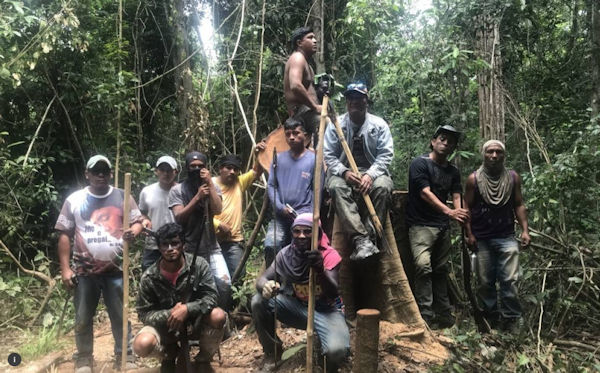 |
| Members of the "Guardians of the Forest" group pose for a photo while on patrol in the Arariboia indigenous protected area in Brazil on 31 Jan 2019. Photo: © Thomson Reuters Foundation/Karla Mendes |
Story links:
- "Fears over rising violence in Amazon as 'forest guardians' battle logging" (text story)
- "Guardians of the Forest" (documentary film)
Supplemental materials (see last item).
Judges' comments: A stupendous piece of vital frontline environmental war reporting on accelerating Amazon rainforest destruction handily won the judges' top pick from a large field of excellent entries. Brazil-based writer Karla Mendes and documentarian Max Baring illuminate the way Guajajara Indians resist illegal loggers stealing trees and leveling jungle on indigenous reserves. So deep in the state of Maranhao that some tribes escape contact with the outside world, the journalists witnessed the activist Indians ousting local invaders who cut roads and build sawmills and farms. The firsthand exchanges shown in "Guarding the Forest" explain the complex forces behind the commercial quest for trees clashing with the need to preserve globally beneficial natural resources in the Indians' thousands-of-year-old home. This strong reporting for Thomson Reuters Foundation News was picked up in English and Portuguese around the world. One of the featured guardians, Paulo Paulino Guajajara, was killed months later in a suspected murder by illegal loggers.
Second Place
"The Great Insect Dying" by Jeremy Hance for Mongabay
Story links:
- "The Great Insect Dying: A Global Look at a Deepening Crisis" (Part 1)
- "The Great Insect Dying: Vanishing Act in Europe and North America" (Part 2)
- "The Great Insect Dying: The Tropics in Trouble and Some Hope" (Part 3)
- "The Great Insect Dying: How To Save Insects and Ourselves" (Part 4)
Judges' comments: In "The Great Insect Dying," journalist Jeremy Hance chronicles the global decline of insects in extraordinary detail that clearly lays out why and where bugs are disappearing, and most importantly, how many we have lost. From Kenya to Puerto Rico, Hance's reporting moves far beyond the car windshield analogy. He uses evocative writing and interviews with two dozen entomologists to craft an engaging, easy-to-understand narrative about the threats facing our insect neighbors across six continents: climate change, habitat loss due to agribusiness expansion and pesticide use. Unlike previous reporting on this topic, Hance pays particular attention to the understudied insect populations of diverse tropical rainforests. This approach greatly elevates his storytelling. The jury wishes to commend Hance for this exemplary piece of explanatory journalism.
Third Place
"The Drought Diaries: Six Families, Three Countries, Six Months" by Obi Anyadike, Hassan Istiila, Anthony Langat and Tonderayi Mukeredzi for The New Humanitarian
Story links:
- "Drought in Africa Leaves 45 million in Need Across 14 Countries"
- "The Drought Diaries: Six Families, Three Countries, Six Months"
- "The Drought Diaries: Benjamin Galwaha, Kenya"
- "The Drought Diaries: Loveness January, Zimbabwe"
- "The Drought Diaries: Aadan Mohammed, Somalia"
Judges' comments: The headline is bad enough: A drought across Africa left 45 million people struggling to find food in 14 countries. Obi Anyadike, Hassan Istiila, Anthony Langat, Tonderayi Mukeredzi and The New Humanitarian went farther. The magazine's reporters in Kenya, Somalia and Zimbabwe spent half a year tracking the drought's impact on six families. Their report, "The Drought Diaries: Six Families, Three Countries, Six Months," documents how the dry spell affected every part of daily life, from food prices to decisions about education. The resulting project includes a monthly record of each family's spending on groceries and other household expenses, along with written updates and video interviews about their progress. The work not only sheds light on the drought, it helps the audience understand the daily lives and aspirations of people in a cross-section of Africa. That combination — passion for the big story and compassion for the people at the heart of the story — is what makes "The Drought Diaries" such an outstanding piece of explanatory journalism. The jurors are proud to recognize it.
First Honorable Mention
"Road to Zero" by Julie Cart for CalMatters
Story links:
- "Despite Sharp Growth in Electric Cars, Vehicle Emissions Keep Rising"
- "'Clean' Freight Traffic Is Elusive As California Rolls Toward Zero Emissions"
- "California Steers Toward a Future of Self-Driving Cars"
- "Can California Put Cars in the Rear-View Mirror?"
Judges' comments: States striving to cut carbon emissions from transportation can look to California's campaign to electrify cars, trains, airplanes and ships. But, as Julie Cart, CalMatters environment reporter, writes, "California must reinvent not only the wheel, but also the vehicle, the fuel and the road." In Cart's clear, zingy style, she rips into the state's climate goal playbook and lets readers know what's working and what hasn't yet worked in the mandated quest to cut greenhouse-gas emissions, nearly half from transportation. "Road to Zero," a series of four stories, finds that electric cars, all-terrain recreational vehicles, front-end-loaders and farm machinery sell. But readily available technology that electrifies trains, trucks, planes and ships is less advanced. The judges were impressed with Cart's grasp of the subject and her ability to convey it to readers. Her stories earned an enthusiastic 1st Honorable Mention.
Second Honorable Mention
"Cancer Cloud" by Brad Schmidt for The Oregonian/OregonLive
Supplemental Materials:
Judges' comments: The Oregonian's Brad Schmidt spent more than a year gathering documents and interviewing public housing residents to see if they'd been exposed to radon, a colorless gas that can cause lung cancer. Schmidt and reporters from the Oregonian's sister newsrooms surveyed 64 public housing and authorities and tested the air at public housing units in six cities. The resulting report, "Cancer Cloud," showed that the U.S. Housing and Urban Development Department ignored a 1988 mandate from Congress to test public housing for radon. Local housing authorities ignored test results and neglected to eliminate radon when it was found. The failure left 400,000 people at risk of exposure to radon, mostly poor families and people of color. In response, 14 lawmakers demanded more funding for radon testing and remediation; HUD itself acknowledged the Oregonian for providing "a kick in the pants." The project also showed the potential for collaboration among small newsrooms, enlisting 25 reporters from seven affiliates. The judges believe it's an outstanding example of explanatory journalism.
Third Honorable Mention
"The Human Cost of Environmental Heat" by Elizabeth Whitman for Phoenix New Times
Story links:
- On 107-Degree Day, APS Cut Power to Stephanie Pullman's Home. She Didn't Live
- How Hot Is Too Hot? AZ Regulators Ignore Science in Weighing Shutoff Protections
- Arizona Regulators Don’t Know What To Do About Summer Shutoffs
Judges' comments: When the mercury climbs past 100 degrees F in Phoenix, what happens to vulnerable residents who can't pay their power bills to stay cool? In "The Human Cost of Environmental Heat," journalist Elizabeth Whitman crafts a brilliant piece of explanatory journalism around the heartbreaking story of Stephanie Pullman, a Sun City West resident who died on a 107-degree day after Arizona's largest utility cut her power due to an unpaid electricity bill. Whitman expertly lays out the state's administrative codes that surround shutoffs and explores how climate change and urbanization are factoring into heat-related deaths in Arizona. The result is a powerful and unique piece of journalism that explains the deadly consequences of what, on the surface, may seem a mundane topic. The Phoenix New Times truly punches above its weight class in this series. Following Whitman's reporting, Arizona temporarily suspended all summers power shutoffs. Indeed, this series is exactly the kind of small-newsroom reporting that SEJ wishes to celebrate.
Outstanding Feature Story (Large Newsroom or Circulation)
First Place
"Our Secret Delta" by Tony Bartelme, Glenn Smith and photographer Lauren Petracca for The Post and Courier
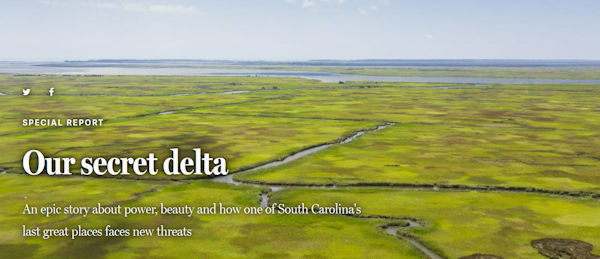 |
| © Lauren Petracca / The Post and Courier |
Sidebar:
Supplemental Materials:
- "Hidden Gems of the Santee Delta" (video)
- "Landscape of the Santee Delta Allows for Unique Data Collection on Alligators" (video)
- Samples of follow-up coverage and editorials (PDF)
Judges' comments: Writers Tony Bartelme and Glenn Smith and photographer Lauren Petracca used lyrical physical description along with significant research to show how climate change and rising sea levels threaten a landscape of historical and economic significance to all South Carolinians. The Santee River Delta is so wild that even a botanist who has studied it for 40 years can get lost in it, yet it is also rich with artifacts from the slaves who cultivated the rice known as "Carolina Gold." This entry, gorgeously executed in the best tradition of storytelling about the environment, left a lasting impression on all the judges.
Second Place
"Guardians of the Amazon" by Dan Harris, Aicha El Hammar Castano, Brian Epstein, Constantine Limperis, Pete Madden, Julian Moura and Evan Simon for ABC News
Supplemental materials:
Judges' comments: There has been a lot of coverage of the deforestation of the Amazon in Brazil, but Dan Harris and his team at ABC News have produced a unique, compelling and important account of how one tribe fights back against illegal loggers. The research, the commitment to telling this story and above all the hard-earned access to the Guajajara tribe as it goes about its dangerous business as "guardians of the forest," shows throughout this original documentary. Right from the beginning, viewers are made to know they are being invited along on an intimate look at dangerous, important work. It's also anchored by excellent production values and leaves viewers feeling like they've been socked in the gut.
Third Place
"The Culling" by Jessica Camille Aguirre for The New York Times Magazine (may require subscription)
Judges' comments: In clear and unflinching prose, Jessica Camille Aguirre reports on Australia's campaign to kill two million feral cats by 2020 to protect its native mammals. Camille Aguirre artfully weaves stories from the hunt with examinations of the moral and ethical implications of the government's decision. She follows scientists trying to better understand cat behavior and those who object to the campaign. The scenes are memorable and brutal, still resonant days after reading.
First Honorable Mention
"City of Oil" by Andrés Caballero and team Marlon Bishop, Antonia Cereijido, Natalia Fidelholtz, Maria Hinojosa, Stephanie Lebow, Janice Llamoca, Miguel Macias and Amy Tardiff for Latino USA
Judges' comments: Journalist Andrés Caballero and the Latino USA team used the story of 9-year-old Nelleli Cobo and her family to draw listeners in to a story of the personal and political impacts of oil drilling that continues, almost ignored, within urban neighborhoods of Los Angeles. Besides exploring the costs to residents' health, this gives a balanced and nuanced presentation of the economic arguments in favor of continued drilling.
Second Honorable Mention
"Cancel Earthworms" by Julia Rosen for The Atlantic
Supplemental materials:
- Live Wire show, with guest Julia Rosen, February 6, 2020, at the Alberta Rose Theatre, Portland, Ore.
- "Coronavirus, Justice Department, Democrats: Your Thursday Briefing," New York Times, February 13, 2020 (may require subscription)
Judges' comments: Julia Rosen's reporting is full of surprises and delights. Worms, it turns out, are not the wholly benevolent critters of the popular imagination. Rosen explains how various species of these invasive "ecosystem engineers" are wreaking havoc across New England's hardwood forests, a landscape that matured after the last ice age with hardly any worms at all. Rosen not only introduces the reader to the scientists attempting to understand the ecological impact of worms. She also ponders the distinctions between environmental change and environmental destruction.
Third Honorable Mention
"The Green Miles" by Gabriel Popkin for Washington Post Magazine
Judges' comments: Gabriel Popkin's story of the small but welcome hope that the damage to Eastern Kentucky's forests from decades of mountaintop removal and strip mining could be undone, and of the remarkable about-face by one of the bureaucrats within the Department of Interior who helped create that disaster and now is helping to reverse its effects, is remarkable. Along the way, Popkin lets the reader in on a seldom-remembered fact about Eastern Kentucky ... it's not just coal country, but timber country, too — or was, and could one day be again. The story works so well in part because of how nimbly Popkin transitions from sharing with the reader minute details of a pair of brothers swimming in a tiny backyard pool on the side of a mountain to reflections from the poet and seer Wendell Berry.
Outstanding Feature Story (Small Newsroom or Circulation)
First Place
"Undone Science: When Research Fails Polluted Communities" by Nancy Averett for Undark
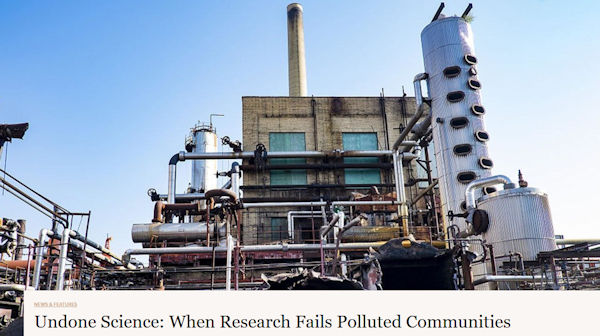 |
| The former Shenango Coke Works on Neville Island, Penn. © Pete Marovich/Bloomberg/Getty Images |
Judges' comments: This compelling and deeply personal story reveals the failure of the research community to put any significant effort into understanding the environmental plight of communities. Focused on the impact of air pollution from a coke plant in Avalon, Pennsylvania, it takes us to other communities where a lack of public information about chemical emissions may have contributed to autism, asthma and cancer. "Undone Science" is an articulate, well-researched and persuasive plea to scientists for data that acknowledges the environmental challenges facing towns, families and their children. It is a powerful reminder that for every Flint, Michigan, there are hundreds of Avalons.
Second Place
"Research and Rescue: Saving Species From Ourselves" by Ashley Braun for Longreads
Judges' comments: From cane toads in Australia to sea lions in California, the human compulsion to save species often misfires. This engaging and well-written story tackles genomic and biotech tools to address not only de-extinction but also conservation challenges. It presents the science and the ethics of gene altering, frozen cell lines and other reproductive science techniques with a mixture of hope and caution. By recognizing that doing nothing is morally difficult for humans, "Research and Rescue" challenges us to think deeply about solutions to extinction, "especially when we are responsible for the troubles in the first place."
Third Place
"Alaskan Roulette" by Zoya Teirstein for Grist
Judges' comments: Zoya Teirstein brings an immediate sense of danger to this public health story exploring the link between a naturally occurring shellfish toxin (PSP) and climate change. Told through the strong and personable voices of Native Alaskans, "Alaskan Roulette" introduces complex science in simple and direct terms to explain the problem facing populations that rely on foraging clams for food and cultural identity. Lovely images of Kodiak Island contrast with stark descriptions of the challenges brought by lack of human resources, government funding and regulations. Like climate change dilemma elsewhere, this story promises no easy solutions.
First Honorable Mention
"The Methane Detectives: On the Trail of a Global Warming Mystery" by Jonathan Mingle for Undark
Judges' comments: Utilizing 'mystery' and 'detective' as metaphors to unravel environmental questions which surround the subject of methane is one of the secrets that makes this comprehensive short piece a winner. The author examines competing hypotheses to explain the unexplainable: why has the amount of methane in the atmosphere been steadily increasing over the past 13 years? An interesting look at the fact that humans and methane are historically connected; that includes food and fuel production as well as waste disposal.
Second Honorable Mention
"Superbug in the Hospital Waste" by Emmanuel Debrah for Joy News
Side bar:
Judges' comments: The world is battling the plague of multidrug resistance, and a populated area of 12 million in Ghana face catastrophic results from antibiotics. Emmanuel Debrah documents the impact of this country's heavy consumption of prescribed drugs and vegetables irrigated by contaminated water. Using interview clips with area medical professionals, he researches the impact of 12 antibodies (the "super bug") on the lives and health of Ghanians. The short film explains that this population has a heightened bacterial resistance to proven medication(s) which influence their rejection of treatment for tuberculosis, HIV, gonorrhea and malaria. This "superbug" poses a dangerous threat to those for whom bacteria have become impregnable to antibiotics.
Third Honorable Mention
"The Pangolin Reports: Trafficked to Extinction" by Xu Jiaming, Elroi Yee, Karen Zhang et al. for The Environmental Reporting Collective
Judges' comments: A well-written report that draws on in-depth investigations across multiple countries to reveal the full story of the illegal pangolin trade. Written by a team of 28 journalists from Africa and Asia, it weaves together a series of narratives to shed light on the impetus for the trade, who is doing what, trafficking routes, methods used by traffickers, law enforcement actions to stop them and gaps in both our knowledge and efforts.
Outstanding Student Reporting
First Place
"Small Farmers Wait for California's Groundwater Hammer to Fall" by Madison Pobis, Stanford University, published in The Bill Lane Center for the American West's "... & the West" blog
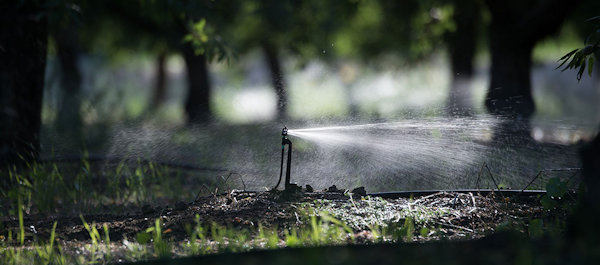 |
| Micro irrigation watering an almond orchard in Livingston, California in 2015. Most growers have already invested in more efficient methods of irrigation like these to increase yields. Lance Cheung/USDA via Flickr |
Judges' comments: The judges found this an impressive overall effort, which combined on-the-ground reporting, extensive use of archival images, videography and data to explain a technical but crucial issue looming as California tries to apportion a shrinking resource — water. The package illustrated the likely human impact on family farmers of arcane water rules, and provided a glimpse of the future as society deals with resource shortages. The writing by Madison Pobis blended the big picture with the human scale, and the videos and data made excellent use of the resources of the Bill Lane Center, government archives and data.
Second Place
"The Nature Cure: Science's Newest Miracle Drug Is Free" by Aaron Reuben, Duke University, published in Outside Magazine, May 2019 print issue
Story links:
Judges' comments: All of the judges were intrigued by this entry. It was a one-person tour-de-force done not by a journalism student but by a PhD candidate in clinical psychology and environmental epidemiology. The reporting was squeezed in over a year between classes, whenever patients cancelled sessions in his clinic, and when Aaron Reuben could tack reporting trips onto conferences. He accompanied physicians into examinations, watched as they sorted through new tools to prescribe exercise, followed patients into walks in the woods and talked with many medical professionals about the challenges and benefits of outdoor experiences. The result was intimate writing with personal scenes, set among clear explanations. Mr. Reuben reports that doctors told him interest in "prescribing nature" skyrocketed after his story was published.
Third Place
"Hurricanes Spawn a Flood of Problems" by Sadira Bacchus, Jessica Horne, Jonathan Miller, Tyana Morris Emberton and Alex Smith, University of North Carolina Pembroke, published in Pine Needle News print and online
Judges' comments: The judges recognized the ambitious reporting done in a diverse and largely impoverished community by students working without the resources of a big journalism school. This collection of reporting looked at the aftermath of two hurricanes that hit southeastern North Carolina, and put a human face on the flooding, on the problems with FEMA, on the pollution and on the modeling done for climate change. With industrious interviews ranging from meteorologists to struggling mothers, the stories painted a picture of an area unprepared and surprised by the storms, and struggling to recover.
First Honorable Mention
"'We See It All:' Wisconsin Rowers on the Front Line of Lake Mendota's Algae Blooms" by Sydney Widell, University of Wisconsin-Madison, published in The Daily Cardinal
Judges' comments: This piece uses solid reporting and a student-first angle to engage readers on an issue that affects the whole community: algae blooms in Lake Mendota. The judges appreciated the unique approach and clear writing.
Second Honorable Mention
"Residents Concerned About Groundwater Pollution From Coal Ash Ponds" by Jamie Hobbs, Danielle Pycior and Tristen Rouse at University of Missouri, published in the Columbia Missourian
Story links:
- "Residents Concerned About Groundwater Pollution From Coal Ash Ponds"
- "MAP: Coal Ash Seeps Into 240 Communities Across the Nation"
- "Columbia Coal Ash Cleanup Pleases Environmentalists"
Supplemental materials: "Community, Activists Dissatisfied With Ameren's Coal Ash Management"
Judges' comments: This was a well-written and well-presented package, including maps, graphics, text, photos and drone footage, that captured the problem of groundwater pollution from coal ash. It portrayed the high emotions involved and governmental failures, and also explored a success story.
Third Honorable Mention
"The Sea Beneath Us" by Grace Mitchell Tada, University of California, Berkeley, published in Bay Nature
Judges' comments: Grace Tada, while a master's candidate in landscape architecture and environmental planning, superbly illustrated the fact that rising seas are pushing the groundwater table up into streets in Oakland and elsewhere in the San Francisco Bay area. The story attracted considerable attention to the problem, and brought funding for her to do continued reporting on the issue in Hawaii.
Rachel Carson Environment Book Award
"Inconspicuous Consumption: The Environmental Impact You Don't Know You Have" by Tatiana Schlossberg
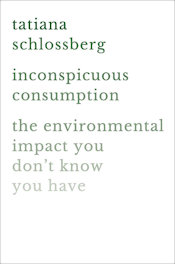 |
First Place
Published by Grand Central Publishing
Judges' comments: In "Inconspicuous Consumption," author/journalist Tatiana Schlossberg warns we've pushed the planet to its limits and highlights the often-overlooked ways in which our daily lives and choices have an impact. Excessive use of electricity, over-buying food and clothes leading to too much e-waste, fuel issues all play a role. Using history, science and a personal narrative, Schlossberg provides a better understanding of both individual and systemic drivers of ecological destruction. Readers will find solace, humor and a route to feeling empowered with possibilities for positive change, rather than drained by an accumulation of bad news.
Second Place
"The Fate of Food: : What We'll Eat in a Bigger, Hotter, Smarter World" by Amanda Little
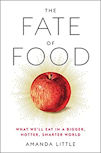 |
Published by Harmony Books
Judges' comments: "The Fate of Food" dives into the economic, agricultural and environmental pressures on the global food supply challenging readers to confront the many ways climate change is affecting the things we eat. Author Amanda Little lays out our potentially dire food future, and introduces readers to people who are working to make food systems more resilient. In an enjoyable read with occasional personal smiles, Little offers reports from around the world and through the intricacies of the global food system to unravel the many connection points between climate change and the future of the food supply. She finds plenty to be worried about along the way, but also notes hope, optimism and people determined to find solutions before the worst impacts occur.
Third Place
"Vanishing Fish: Shifting Baselines and the Future of Global Fisheries" by Daniel Pauly
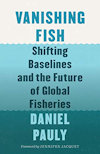 |
Published by Greystone Books Ltd.
Judges' comments: With the personal and scientific essays collected in "Vanishing Fish," marine scientist Daniel Pauly bears witness to the wholesale depletion of marine ecosystems over the past five decades. Pauly's sharp observations make the reader a co-witness to the destruction caused by the way our economy relates to nature; his forceful prose makes his call for reform impossible to ignore.
First Honorable Mention
"Into the Planet: My Life As a Cave Diver" by Jill Heinerth
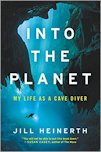 |
Published by Ecco/HarperCollins
Judges' comments: "Into The Planet" follows reporting author and cave diver Jill Heinerth recorded as she and others pushed human limits as they explored and gathered data from the depths of the earth. Life as a cave diver into the veins of Mother Earth, in spite of danger, promises to leave the world a better place.
Second Honorable Mention
"As Long As Grass Grows: The Indigenous Fight for Environmental Justice From Colonization to Standing Rock" by Dina Gilio-Whitaker
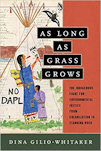 |
Published by Beacon Press
Judges' comments: In "As Long as Grass Grows," Dina Gilio-Whitaker questions the rights of nature and community rights as she reports the history of resistance to incursions on Indian lands. Activism is reported during the Standing Rock Saga in 2014 as she warns of Earth's 6th mass extinction. "We're all on the reservation now," she writes.
Third Honorable Mention
"Floating Coast: An Environmental History of the Bering Strait" by Bathsheba Demuth
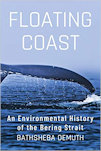 |
Published by W. W. Norton & Company
Judges' comments: In "Floating Coast," environmental historian Bathsheba Demuth focuses intently on the region of the Bering Strait to reveal broad themes of survival and ambition, exploitation and resilience, and the ongoing clash of global ideologies. Demuth weaves an engrossing story of a ravaged ecosystem from archival research, contemporary interviews and first-hand observations.
Esteemed Judges, 2020 SEJ Awards for Reporting on the Environment
Jane Braxton Little, Independent Journalist
Merrill Brown, CEO, The News Project, Inc.
Denis Cuff, Reporter, Bay Area News Group
Gloria Dickie, Independent Journalist
Dan Fagin, Professor of Journalism and Director of the Science, Health and Environmental Reporting Program, New York University
Beth Gardiner, Independent Journalist
Michael Grunwald, Senior Writer, Politico
Thomas Hayden, Professor of the Practice, Earth Systems; Director, Environmental Communication Graduate Program, Stanford University
Erin Hayes, Retired Journalist, ABC News; Educator, College of the Ozarks
Rebecca Hersher, Reporter, National Public Radio
Sharon Honore, Associate Professor of Communications, University of the Virgin Islands
Don Hopey, Environment Reporter, Pittsburgh Post-Gazette
Derrick Jackson, Fellow, Union of Concerned Scientists; Contributor, Grist.org
Cheryl Katz, Independent Journalist
Jane Kay, Independent Journalist
Elaine Kurtenbach, Asia Business Editor, The Associated Press
Mike Lee, Reporter, E&E News
Michael Lindenberger, Deputy Opinion Editor, Houston Chronicle
Randy Loftis, Lecturer, Mayborn School of Journalism, University of North Texas; former Journalist, Dallas Morning News
Mary Mazzocco, Retired Journalist, Contra Costa Times; Educator, Diablo Valley College
Darlene W. Natale, Professor, Journalism and Mass Communication, University of North Carolina, Pembroke
Laurel Neme, Independent Journalist
Brian O'Donoghue, Professor, University of Alaska Fairbanks
Katina Paron, Director, Institute for Environmental Journalism, InsideClimate News
Francis Plourde, Producer, CBC/Radio-Canada
Sinduja Rangarajan, Senior Data Journalist, Mother Jones
Neena Satija, Investigative Reporter, Texas Tribune
Susan Sharon, Deputy News Director, Maine Public Radio
Douglas Struck, Freelance Reporter; Journalist-in-Residence, Emerson College
JoAnn Valenti, Emerita Professor, Brigham Young University
Brett Walton, Reporter, Circle of Blue
Tim Wheeler, Associate Editor and Senior Writer, Bay Journal
Trish Wilson, Environment Editor, The Washington Post
SEJ 2020 Awards Committee
Emilia Askari, Independent Journalist
Jeff Burnside, Independent Journalist
Katy Daigle, Science News
Parimal Rohit, The Log newspaper
Rae Tyson, Freelance Journalist
Director of SEJ Awards
Chris Bruggers, Awards Director, Society of Environmental Journalists, (202) 558-2022













 Advertisement
Advertisement 



